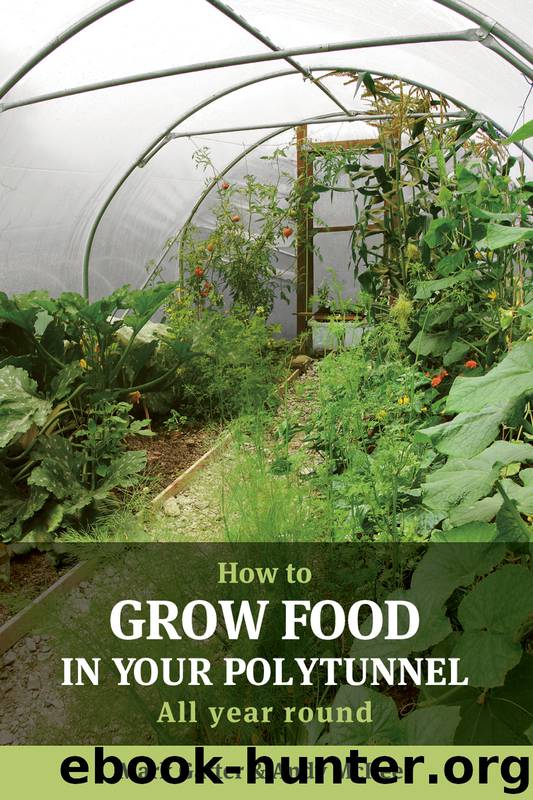How to Grow Food in Your Polytunnel by McKee Andy Gatter Mark

Author:McKee, Andy, Gatter, Mark
Language: eng
Format: epub
Publisher: UIT Cambridge Ltd.
Goji (pronounced go-jee) berries are expensive to buy in the shops but easy to grow yourself, and are very hardy after their first year. They are credited with an impressive list of health benefits, and are high in a selection of vitamins, minerals and antioxidants. Best of all, they do very well in pots.
Preparation
Goji berries are perennial and once established are very easy to care for. They will grow in a wide variety of soils (unless too wet), don’t need a lot of feeding, are somewhat drought-tolerant and will even grow in partial shade, though they prefer full sun. They make ideal container plants and should certainly be grown in the shelter of a polytunnel (or greenhouse) in their first year, after which they could be moved to a sheltered spot outside. Or, of course, they can stay in the tunnel, where they will give heavier yields than outside. Ideally they prefer a rich, well-drained loam into which some very well-rotted compost has been added to help moisture retention.
Sowing
Goji seeds germinate best at around 20°C and should be sown 1cm deep in 10cm pots. Germination is patchy but should take around two weeks. Young plants are also commercially available, either bare-rooted or already growing in a pot.
Note: In April 2008 it became apparent that bare-rooted goji berry plants were being imported from China to Holland and from there to the UK, bypassing the normal inspection channels. Some of these plants carried the goji gall mite, a pest to which goji berries are prone in their natural homelands. This is not indigenous to the UK but if introduced may spread to other plants in your garden, so it is important to always buy goji plants from a reputable source.
Growing
If you do buy a bare-rooted plant, plant it – as soon as it arrives – in a 30cm pot. Do not add any bonemeal, fertiliser, etc. to the earth when planting, as it will be far too rich and may damage or even kill the roots. Water the plant in, and add a mulch to the surface. Leaves should appear within three weeks.
Goji is invasive, so we do not recommend planting it directly in the tunnel. Pot the plant on only when it needs it, and never into anything much larger than that in which it was previously growing, or the roots can become waterlogged. If you are planting into the soil beds, however, leave about 1 metre between bushes. Left to themselves, they can grow into thick bushes 2-3 metres tall and put out vines that reach even further. Regular pruning is therefore required to form them into smaller, compact bushes that will produce loads of berries.
Goji berry plants should not be allowed to get dry, especially in their first year. It’s better to give a heavy watering on a weekly basis rather than a light sprinkle every day or so.
The plants should be cut back each year in spring just as growth begins. This will encourage a dense habit, and some of the cuttings can be rooted for new plants.
Download
This site does not store any files on its server. We only index and link to content provided by other sites. Please contact the content providers to delete copyright contents if any and email us, we'll remove relevant links or contents immediately.
| Container Gardening | Hydroponics |
| Organic | Propagation & Cultivation |
| Topiary | Urban |
| Water Gardens & Ponds |
Turbulence by E. J. Noyes(7939)
The Thirst by Nesbo Jo(6829)
Gerald's Game by Stephen King(4583)
Be in a Treehouse by Pete Nelson(3951)
Marijuana Grower's Handbook by Ed Rosenthal(3623)
The Sprouting Book by Ann Wigmore(3543)
The Red Files by Lee Winter(3368)
The Remains of the Day by Kazuo Ishiguro(3295)
Sharp Objects: A Novel by Gillian Flynn(2958)
Christian (The Protectors Book 1) by L. Ann Marie(2654)
Organic Mushroom Farming and Mycoremediation by Tradd Cotter(2630)
The Culinary Herbal by Susan Belsinger(2432)
Stone Building by Kevin Gardner(2353)
The Starter Garden Handbook by Alice Mary Alvrez(2284)
Lilac Girls by Martha Hall Kelly(2258)
The Unlikely Pilgrimage of Harold Fry by Rachel Joyce(2221)
The Lean Farm Guide to Growing Vegetables: More In-Depth Lean Techniques for Efficient Organic Production by Ben Hartman(2096)
Urban Farming by Thomas Fox(2061)
Backyard Woodland by Josh VanBrakle(1895)
